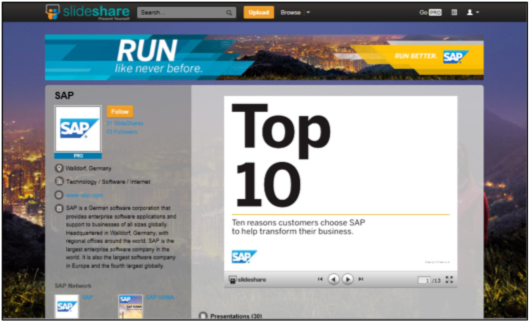The Growing Importance of Niche Social Networks
Social media can’t really be called “mature,†but relatively speaking, the social networking space has settled into a now-familiar pattern, with Facebook as the undisputed leader, boasting over 900 million members worldwide, and with a notorious IPO experience still making headlines. Competitors like MySpace have fallen by the wayside.
As markets mature, the typical next stage of evolution is differentiation, and the arrival of smaller players who fill a niche that the behemoths cannot serve. Social networking is following this same path, with the arrival of myriad niche networks, each vying for a piece of the action. From a marketer’s perspective, niches are valued for delivering targeted audience segments who tend to be more enthusiastic and loyal.
According to a study presented by the research company eMarketer, 70% of marketers are increasing their spend in 2012 on efforts to reach customers and prospects across multiple social networks. No surprise, the largest beneficiaries of this broader interest is the niche networks like FourSquare, Tumblr and SlideShare.
Let us look at a few of the new social networks that are intriguing marketers in the U.S. today.
Pinterest
The social image-sharing site Pinterest burst on the scene in early 2012, growing fast, and gaining enormous amounts of attention from users, the press, and of course marketers. A March 2012 study from Bizrate Insights said that 32% of image-sharing site users eventually purchased a product after seeing it “pinned.†However, the study also suggested that some users have trouble finding the product online after being attracted to it by a friend’s pin.
Pinterest is becoming a trusted network especially among female users. A February study from BlogHer said 81% of active female Pinterest users trusted the site for information and advice, compared with 33% for Facebook and 31% for Twitter.
So how are brands taking advantage of Pinterest? The site does not take advertising. So brands are creating “pinable†content, and getting it disseminated online so that Pinterest users will pin, comment and like the image. Because Pinterest is all about visuals, versus text, brands are using attractive product shots, infographics, and charts. A quick scan of Pinterest confirms that popular categories are food, pets and fashion.

The image-sharing category is now mobbed with competitors, like Polyvore, Discoveredd, The Fancy and Juxtapost. Even in a niche, a shakeout is probably on the horizon.
Tumblr
The micro-blogging platform Tumblr, founded in 2007, has grown to nearly 60 million users. Tumblr uniquely combines aspects of social media and blogging, providing users with a dashboard to follow other bloggers and create their own posts.
A few months ago, Tumblr began accepting advertising. And early advertiser was Adidas, which launched an official Tumblr blog in conjunction with the UEFA European Championship soccer tournament in Poland and Ukraine in June. The ad unit appeared on the Tumblr “Radar†section of the dashboard, and content selected by sports journalists rotates throughout the day. Adidas was already an active Tumblr blogger, with a series called , focusing on athletic shoe fashion.

Tumblr Radar’s Adidas ad unit
Huggies diapers marketing on Tumblr
Huggies created a humorous campaign on Tumblr to promote its Little Movers Diapers line. Recognizing that babies have a strong point of view, but can’t talk, the campaign gave babies a voice, to tell their parents exactly what they want—such as a diaper that is shaped to fit their bodies.
The campaign featured four “baby bloggers,†each with a different personality. Their posts were cute pictures with short captions posted daily, and targeted at moms, to encourage them to share the captioned images with other moms.
At launch, the Tumblr campaign outpaced the Huggies Little Movers Facebook page, gaining 67,000 page views, compared to 13,000 page views on Facebook. The brand has continued to launch campaigns for diaper and wipe sub-brands on Tumblr, seeing a spike with each new campaign.
SlideShare
SlideShare, the social network for sharing PowerPoint slide presentations, with over 60 million monthly users, has become a valuable marketing tool in many ways. The most straightforward way to market by SlideShare is posting sales and marketing presentations, which can be found easily by customers and prospects.
To enhance the power of their slide posts, marketers are following these tips:
- Add background notes to your slides, which make the presentations more valuable, and also enable better search results for your content.
- Add tags to the post, for improved searchability.
- Create your slides will less text and more visuals, like photographs, infographics and charts.
- Use educational, non-sales-y content.
- Use your company name for your SlideShare account.
- Promote your presentation via Twitter and Facebook, and embed it in blogs.
SlideShare also accepts banner advertising and offers paid memberships whereby companies can create their own branded “channels†of content.

SAP is just getting started with a channel on SlideShare, with 31 presentations posted, and 81 followers.
The newest development is social networks designed specifically for mobile usage, like Path, Instagram (recently bought by Facebook for $1 billion), Highlight (for finding nearby friends) and SoundTracking (to share what you are listening to). As the social networking category matures, and more niche networks arrive, marketers will have ever more options to reach their target audiences.


